Stuart Weitzman School of Design
102 Meyerson Hall
210 South 34th Street
Philadelphia, PA 19104
Get the latest Weitzman news in your Inbox
A Civic Vision For the Central Delaware: Phasing
Though A Civic Vision for the Central Delaware outlines a long-term ideal for the riverfront, numerous phases are required to implement the plan. These depend to a large extent on federal, state and city funding cycles, future planning efforts and private development initiatives.
In order to ensure the success of the vision, this plan focuses on short-, mid-, and long-term initiatives, as well as on early action efforts that can be implemented immediately. Short-term initiatives center on key investments in public areas that could establish the vision’s most important elements and lay the groundwork for future efforts. Mid-term initiatives will require greater planning and coordination between agencies; they will create significant physical change and help elevate the profile of the central Delaware riverfront locally and regionally. Long-term initiatives are high-profile, riverfront defining projects that could have a major impact on the river, the city, the state and the region. They are transformative projects that can come to fruition only through collaborative leadership, ongoing community support and time.
Phasing (pdf)
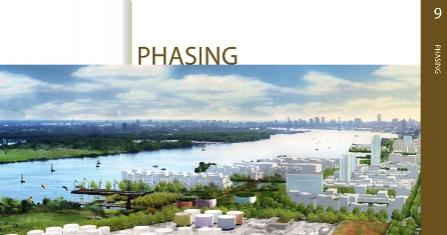
Early Actions
These projects focus on public open-space initiatives that can happen quickly. They are high-impact, demonstration projects designed to showcase what is possible along the central Delaware. Many of these projects will serve as prototypes for future and/or ongoing development and will help to demonstrate the overall intent of the civic vision to the public.
Though A Civic Vision for the Central Delaware outlines a long-term ideal for the riverfront, numerous phases are required to implement the plan. These depend to a large extent on federal, state and city funding cycles, future planning efforts and private development initiatives.
In order to ensure the success of the vision, this plan focuses on short-, mid-, and long-term initiatives, as well as on early action efforts that can be implemented immediately. Short-term initiatives center on key investments in public areas that could establish the vision’s most important elements and lay the groundwork for future efforts. Mid-term initiatives will require greater planning and coordination between agencies; they will create significant physical change and help elevate the profile of the central Delaware riverfront locally and regionally. Long-term initiatives are high-profile, riverfront defining projects that could have a major impact on the river, the city, the state and the region. They are transformative projects that can come to fruition only through collaborative leadership, ongoing community support and time.
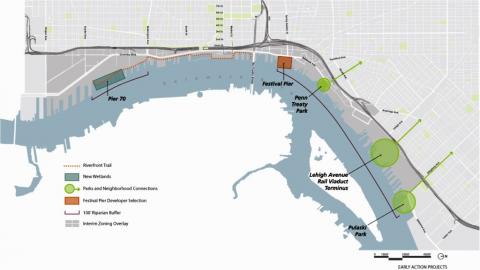
Work with the Center City District to launch a two-mile interim bike trail from Pier 70 to the Benjamin Franklin Bridge that will showcase the recreational potential of the future river trail.
Enhance Penn Treaty Park and Pulaski Park through collaborative initiatives with the state Department of Conservation and Natural Resources (DCNR) and local community groups. Citizens participating in the vision plan and in the New Kensington CDC’s neighborhood- planning efforts identified Penn Treaty Park as the jewel of the central Delaware, while Pulaski Park is revered by its Port Richmond neighbors and has tremendous potential to serve as an important neighborhood green space and to provide a linkage along Allegheny Avenue to Campbell Square.
Evaluate the cost and feasibility of creating park space at the terminus of the Lehigh Avenue rail viaduct, an untapped potential recreational resource that could serve as a gateway to the riverfront for Kensington and Port Richmond.
Construct tidal wetlands, meadows and floodplain forest at the existing finger piers adjacent to Pier 70 in conjunction with efforts by the Philadelphia Water Department and the Pennsylvania Department of Environmental Protection’s efforts to meet the federal mandate of the Clean Water Act.
Work with the Penn’s Landing Corporation to craft a Request for Qualifications and Request for Proposals for the redevelopment of the Festival Pier/Incinerator site as an integrated public park space and development parcel.
Draft and adopt an interim zoning overlay to establish development standards for the central Delaware. At a minimum, the zoning ordinance should mandate a 100-foot buffer for public riverfront access where feasible and create use and design guidelines for riverfront development. Design guidelines could address view corridors, parking requirements, building height and bulk, floor-area ratio and density, setbacks/build-to lines, facades, signage, streetscape and stormwater management. Implementing this ordinance requires cooperation between key city departments including City Council, the Philadelphia City Planning Commission, the Zoning Code Commission and the City of Philadelphia Law Department.
These early action projects will encourage greater pedestrian activity and establish standards for pedestrian-scaled, urban mixed-use developments. Improving and developing quality open space and accessibility are primary steps in reclaiming the river and bringing Philadelphians back to their riverfront.
Short-Term Initiatives
Due to the intensity of development pressures on the central Delaware riverfront, the civic vision outlines a series of short-term initiatives that could be implemented in the coming years. These initiatives would form the foundation of the overall vision. Key elements of the vision, such as Delaware Boulevard and the park system, would take shape during this phase. These initiatives are divided into two categories with equally important impacts effects:
Background Projects: Policy/study oriented projects that would serve to institutionalize the elements of the plan frameworks— movement systems, parks and open space, and land development.
High-Visibility Projects: Physical projects that would serve as milestones and have significant regional implications.
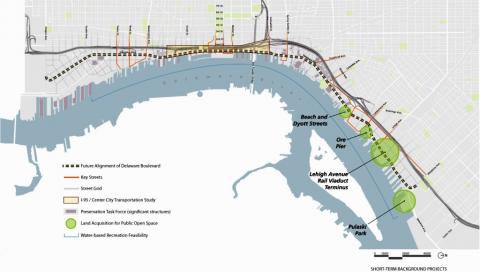
Background Projects
Institute policies to provide density bonuses to developers to foster the development of mixed-income housing, “sustainable” buildings, historic preservation and adaptive reuse, and transit-oriented development. Through density bonuses, the city would demonstrate its commitment to a better built environment and ensures that the riverfront remains accessible to all Philadelphians.
Establish a trust to target priority land acquisitions for public open space.
Conduct additional research on potential funding sources and management structures. Mobilize city and state officials to begin implementing the strategies proposed.
Form a historic preservation task force to ensure that historical structures within the project area are preserved and that tours or markers illustrate the riverfronts’ evolution from its colonial and industrial eras to the present.
Modify the official city plan to extend key city streets to the riverfront and establish the ideal alignment for the redesigned Delaware Boulevard. This action would define the city’s intention to incorporate new streets into future development.
Conduct a feasibility study for the proposed transportation network along the central Delaware. This would focus on reconstructing I-95 at Center City, and would address the long-term economic, environmental, and engineering feasibility of connecting the foot of Market Street and Old City with Delaware Boulevard and the river. Options include covering or putting the highway below grade.
Capitalize on the transit-alternatives analysis being undertaken by the Delaware Regional Port Authority to develop an implementation plan for mass transportation options along the riverfront. Further studies should produce designs for possible rail systems, identify future station locations and address further integration with SEPTA or PATCO.
Adopt a Complete Streets policy to ensure that standards for multi-modal movement and public access are met.
Assess feasibility of and locations for water-based recreation activities given the central Delaware’s water currents and industrial uses.
Conduct an ecological study that outlines the impact future riverfront development on the Delaware watershed.
Encourage ongoing planning studies at the neighborhood level. To this end, the Delaware Valley Regional Planning Commission is seeking funding to support further planning, project design, programming and early-action projects for riverfront neighborhoods. Additionally, the Philadelphia City Planning Commission will play an important role in coordinating these neighborhood-planning efforts.
Encourage collaboration between the City Planning Commission and the Bicycle/Pedestrian Advisory Task Force on a study of how to integrate car sharing and bike sharing into the central Delaware transit network.
Coordinate a public-education campaign to ensure ongoing support for the civic vision. It is important that stakeholders in key leadership positions endorse the overall vision and understand the economic and quality-of-life benefits that are attached to a revitalized riverfront. Public education must occur at all levels—among neighborhood leaders, city leaders and the development community, as well as throughout the city as a whole.
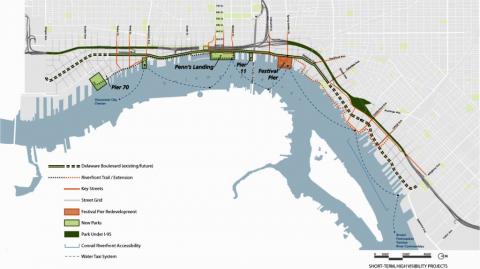
High-Visibility Projects
Design, construct and expand the interim riverfront trail that will be implemented as one of the civic vision’s early action projects. To do this, the city must develop clear design guidelines for the trail so it can be built on city-owned parcels and in conjunction with development projects. It is important that the design guidelines correspond with the standards developed for the north Delaware riverfront. Progress in implementing the trail will serve as a symbolic gesture, reinforcing the city’s commitment to the revitalization of its riverfront. Partnership opportunities with public agencies and private developers exist, and productive partnerships will help garner funding, expand limited resources and expedite the trail’s completion.
Create spaces for a range of active uses underneath I-95. Proposed amenities include stormwater parks, rain gardens, green parking, pedestrian trails and paths, recreation facilities and civic portals. At first, this effort will be completed in conjunction with improvements to the Girard Avenue interchange section of I-95. Later, this project may serve as a prototype for future infrastructure reconstruction.
Begin the redesign of Delaware Boulevard, a roadway that will serve as the spine of future riverfront activity. Though the boulevard will be completed in an incremental fashion, key improvements made from the onset will serve to establish the framework for the ongoing development of the roadway. Initial implementation phases should focus on interim improvements within the existing right-of-way. Interim improvements include maintaining the current width of the boulevard to allow for traffic pressures associated with new development, widening sidewalks to encourage greater pedestrian activity and incorporating a landscaped median along the length of the entire boulevard. Existing rights-of-way include these:
In the north, Beach Street (between Cumberland Street and Schirra Drive and Dyott Street and Marlborough Street);
In the central, Delaware Avenue/Columbus Boulevard (Marlborough Street to Washington Avenue); and
In the south, Columbus Boulevard (Washington Avenue to Oregon Avenue).
Acquire the necessary rights-of-ways required to establish the boulevard along the entire length of the riverfront. This would include another between Cumberland St. and Lehigh Ave., and an extension of Lehigh Ave from Richmond St. to Delaware Boulevard a small area of private property between Dyott Street and Schirra Drive.
Begin to extend major Philadelphia streets to the riverfront at key locations. These streets will provide connections to the river and serve as gateways to the neighborhoods. These essential connector streets include Lehigh Ave., Cumberland St., Columbia Ave., Spring Garden St., Frankford Ave (connecting with Ellen St.), Washington Ave., Dock St., Reed St. and Tasker St. Along with providing these key roadway connections, these streets should be a part of a comprehensive streetscape and tree-planting effort to further link neighborhoods to the riverfront.
Develop a series of signature parks. Research shows that well-designed public spaces serve a catalytic function for development and encourage public support for publicly financed improvements. Two key demonstration projects include the development of green public space on the northern end of Penn’s Landing and on Pier 11 beneath the Benjamin Franklin Bridge.
Work with Conrail and possibly the Pennsylvania Industrial Development Corporation (PIDC) to ensure that the portions of the Port Richmond rail yards adjacent to the river remain accessible to the public despite the potential for the property to become a light-industrial center.
Establish dedicated rights-of-way for buses along Delaware Boulevard to improve the efficiency of public riverfront transit. Bus Rapid Transit (BRT) can serve Philadelphia well as an interim approach to improved mass transportation along the riverfront.
Finish design and construction of the Festival Pier/Incinerator site at Spring Garden Street. The city-owned parcel could be designed to include commerce, culture, open space and development. In conjunction with this development, investments should be made in the Spring Garden Street station of the Market-Frankford line.
Develop green space and create public riverfront access at the foot of Washington and Snyder Avenues in South Philadelphia. These riverfront parks may include tidal wetlands and revitalized piers to provide new venues for fishing and boat docking.
Establish a water-taxi system to support riverfront activity and provide connections north and south along the river and east to Camden.
Though a long-range vision serves to promote big ideas, short-term action items are necessary to build momentum for the civic vision and develop the political will to execute the larger plan. Small successes demonstrate the viability of the vision, providing tangible benefits to the city as a whole.
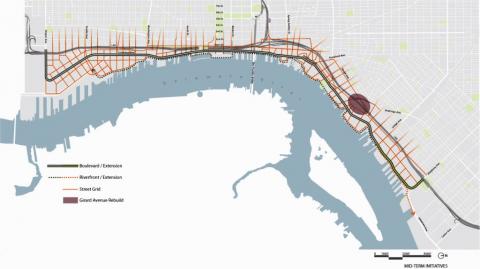
Mid-Term Initiatives
While development pressures are already affecting the riverfront in the short term, it is important that the city establish mid-term initiatives to define the context for longer-term goals, objectives and projects that have larger citywide and regional implications.
Develop partnerships. There are multiple opportunities for collaboration between city and state agencies. In particular, the Philadelphia Water Department (PWD) is under a federal mandate to construct a combined sewer outfall, and PennDOT will make a significant infrastructure investment as it begins the reconstruction of I-95 through Center City. Integrated planning efforts between PennDOT and the PWD could help these agencies maximizethe limited funding each agency has for infrastructure improvements.
Complete Delaware Boulevard. In the mid-term, the boulevard should be implemented from Lehigh Avenue to Allegheny Avenue along the river’s edge. This extension of the boulevard in this location will maximize the development potential of the underutilized Port Richmond rail yards, and also create a foundation for future development.
Work with PennDOT to realize long-term interchange reconstruction roadway improvements in conjunction with the Girard Avenue. In order to accommodate vehicular detours during construction, PennDOT plans to build a temporary roadway through the Conrail lands from Cumberland Street to Allegheny Avenue. This civic vision recommends that the city and PennDOT work together to ensure that the temporary detour route becomes integrated into the proposed road network as a part of a new Delaware Boulevard.
Construct the additional streets necessary to build the proposed street network that would extend Philadelphia’s city grid on the west side of I-95 to the river’s edge. Many of these streets could be developed in combination with privately funded development projects. The network of streets would form urban block sizes that could be adopted to serve different uses over time. A network of streets, with its accompanying infrastructure for utilities (sewer, water, power, etc.), offers a ready template for new types of development.
Complete the riverfront trail so that it is continuous throughout the project area. This trail will serve as Philadelphia’s portion of the East Coast Greenway, which links Maine to Florida by a continuous bike path.
Add amenities to the riverfront including, water recreation, public art, historical markers, attractive landscaping and active programming that helps define the trail and parks.
The completion of mid-term projects will offer significant milestones that will generate continued interest in the future of the riverfront. Many of these projects will require establishing a balance between public and private interests.
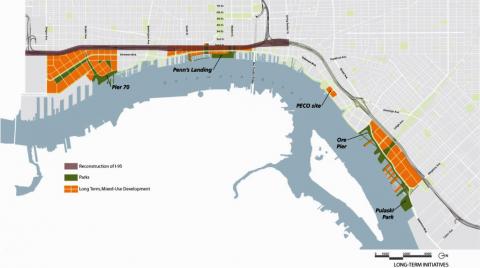
Long-Term Initiatives
After years of development and progressive implementation of open space and circulation frameworks, the central Delaware riverfront could consist of an eclectic mix of uses and park spaces that extends Philadelphia’s signature urban style to the river’s edge. As development fills in along the street and open-space networks, landmark projects such as the following could stimulate continued riverfront development
Complete the development of Delaware Boulevard. Increased population density, public-space amenities, mass transit and an integrated road network could dramatically alter the character of what is currently Delaware Avenue/Columbus Boulevard. As mass transportation and additional road networks develop, Delaware Boulevard could decrease in size—becoming two lanes in each direction—with permanent mass-transit options accommodated within a defined transit median. Decreasing the width of Delaware Boulevard could help calm traffic and create a pedestrian-oriented street. At full operation, a Delaware River transit line could link with ferries at Penn’s Landing, the existing SEPTA No. 15 trolley at Girard Avenue, the Market-Frankford line at Second and Market Streets, PATCO at Franklin Square or the Benjamin Franklin Bridge, and the southern extent of the Broad Street line near the Sports Complex. Transit could have an identity of its own to match the character of the completed boulevard.
Begin the reconstruction of I-95 in the southern and central sections of the central Delaware. Collaborative partnerships between city, state and federal agencies in the short- and mid-term could result in new ways of thinking about the future of the interstate; thereby reconnecting the city to the riverfront by eliminating the barrier-like quality of I-95. This could be accomplished through capping, or creatively bridging the highway, or placing an interstate below grade.
Along with the redesign of I-95 in Center City, complete the open space and marina at Penn’s Landing, creating a signature green space on the Delaware through an international design competition.
Redevelop the PECO site as an alternative energy generator or a commercial, performance or art space. The adaptive reuse of this iconic building would create a new landmark along the riverfront and complement an improved Penn Treaty Park.
Begin to develop new, medium-density, mixed-use development between Washington and Oregon Avenues as the big-box retail buildings in South Philadelphia near the end of their economic cycle. Initial steps could include these:
Coordinating with the port to define its role as an anchor institution;
Establishing the street grid in order to define parcels for future development. This includes developing Weccacoe Ave. as an extension of Delaware Boulevard;
Developing an inland park to provide recreation opportunities where access to the riverfront is limited due to port activities; and
Incorporating community facilities, such as a charter school or port-related job training centers.
Complete the transition of the Port Richmond rail yards into a business park and mixed-use community. With the addition of the boulevard and a new street network through the Port Richmond rail yards, the currently anticipated light industrial complex can transition into a twenty-first century business park—encompassing a mix of industrial, commercial and retail uses—and serve as an employment center for the city. This business center could be designed to attract knowledge industries connected with the region’s universities and medical and pharmaceutical communities.
The high profile projects discussed above represent the culmination of multiple early actions and short-term and mid-term initiatives that can raise the city’s national and international profile as a world-class riverfront. When these signature projects are considered within the context of a phased implementation, it becomes evident that A Civic Vision for the Central Delaware sets forth an ambitious but attainable future for Philadelphia.
Next Steps
A Civic Vision for the Central Delaware outlines an overall vision for seven miles of Philadelphia’s original riverfront, presenting the goals of the vision in three overarching frameworks—movement systems, parks and open space, and land development. The civic vision was developed in a year long public process and reflects the aspirations of the citizens of Philadelphia.
Philadelphia can advance the civic vision and the future of its Delaware riverfront through the implementation of these bold but achievable next steps. Seizing this unique opportunity to shape the public realm along the central Delaware will signal that the time for progressive change in the city of Philadelphia has arrived.
Though this ends one step in the Central Delaware Riverfront Planning Process, it marks the beginning of a new phase for Philadelphia and the Delaware riverfront. Persistence will be necessary in order to implement this vision, which begins with the following short-term initiatives:
Movement Systems: Establish Delaware Boulevard on existing rights-of-way, beginning to form the spine of a new street network that will extend the city to the river.
Park and Open Spaces: The civic vision encourages collaboration between city and state entities in order to implement an interim bike trail along the riverfront and improve two neighborhood parks—Penn Treaty Park and Pulaski Park. Funding is available for these public space improvements to begin as early as 2008. This will help animate the riverfront and build momentum for future parks projects.
Land Development: The plan recommends that the city adopt an interim zoning overlay to establish development standards for the Central Delaware.
Implementation: In collaboration with civic leaders, Penn Praxis plans to publish an implementation plan. The plan will:
Set out detailed action steps.
Recommend an order for achieving these actions where they need to be phased in over time.
Put forth a detailed strategy for obtaining the necessary legislation, land and rights of way, funding, and other prerequisites to make this vision a reality.
Foster the continuation of the civic dialogue.
